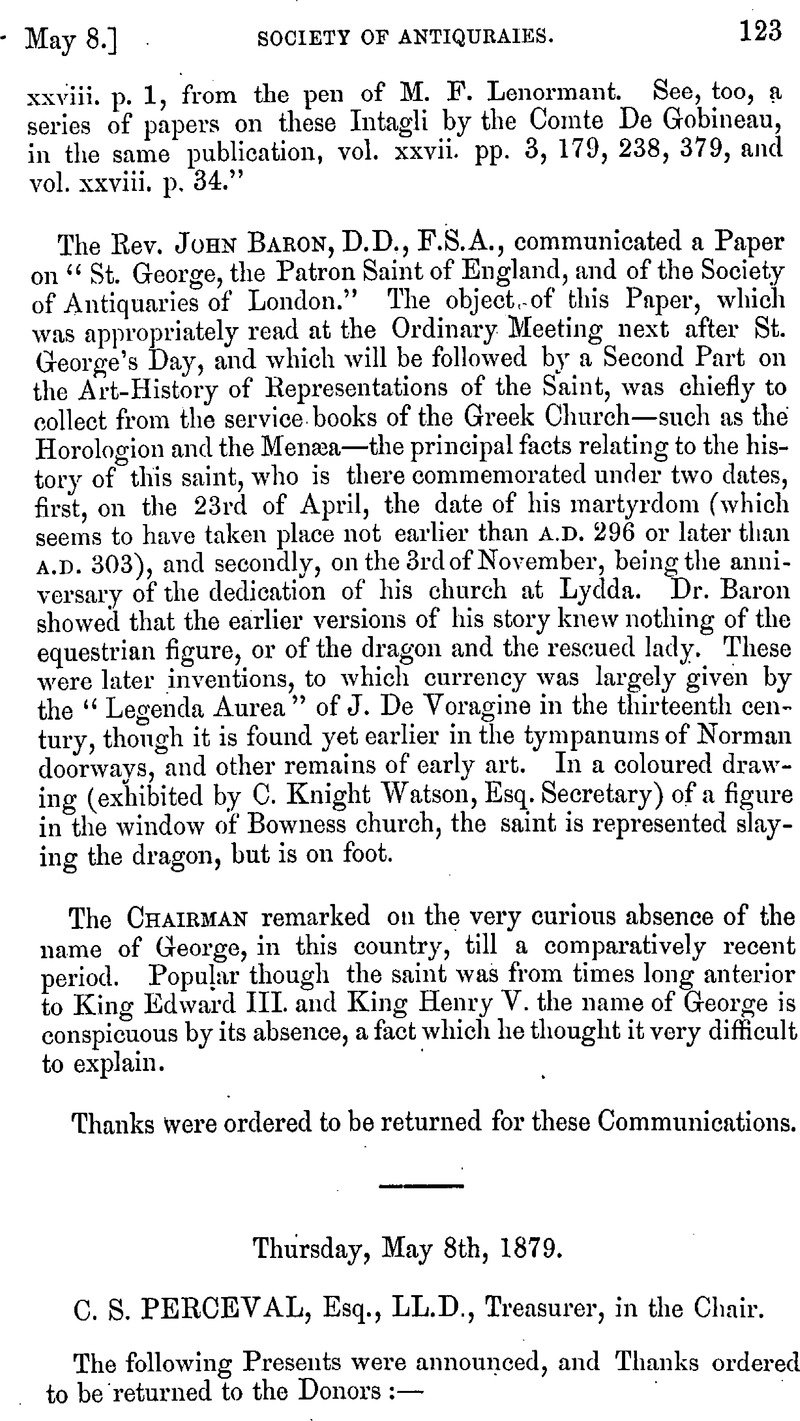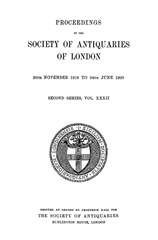No CrossRef data available.
Article contents
Thursday, May 8th, 1879
Published online by Cambridge University Press: 10 May 2010
Abstract

- Type
- Proceedings
- Information
- Copyright
- Copyright © The Society of Antiquaries of London 1881
References
page 129 note * On the Decay of Glass, &c. (Archæologia, vol. xlvi.)
page 129 note † Chemical News, vol. xxxvi. p. 227.
page 130 note * Chemical News, March, 1865, p. 154.
page 132 note * Gent. Mag. 1799, vol. Ixix. part 2, p. 641; Horsfield, Hist, of Sussex, ii. 103; Lower, Compendious Hist, of Sussex, ii. 157; Murray, Handbook for Kent and Sussex, p. 368.
page 134 note * Hone, in his Every-Day Book (1826, i. 1600, Dec. 21), thus describes it. “There is a sheet of carols headed thus: christus natus est: Christ born; with a woodcut, 10 inches high by 8½ inches wide, representing the stable at Bethlehem; Christ in the crib, watched by the Virgin and Joseph; shepherds kneeling; angels attending; a man playing on the bagpipes; a woman with a basket of fruit on her head; a sheep bleating and an ox lowing on the ground; a raven croaking and a crow cawing on the hay-rack; a cock crowing above them; and angels singing in the sky. The animals have labels from their mouths, bearing Latin inscriptions. Down the side of the woodcut is the following account and explanation: ‘A religious man, inventing the conceits of both birds and beasts, drawn in the picture of our Saviour's birth, doth thus express them: The cock croweth, ‘Christus natus est,’ Christ is born. The raven asked, ‘Quando ?’ When ? The crow replied, ‘Hac nocte,’ This night. The ox cryeth out, ‘Ubi? Ubi ?’ Where ? Where ? The sheep bleated out, ‘Bethlehem, Bethlehem.’ A voice from heaven sounded, ‘Gloria in excelsis,’ Glory be on high.–London: Printed and sold by J. Bradford, in Little Britain, the corner-house over against the Pump, 1701. Price One Penny, (This carol is in the possession of Mr. Upcott.)”
page 135 note * St. Bernard, quoted in Leg. Aur. cap. xiv.
page 135 note † Leg. Aur. cap. vi. The whole passage is curious, but too long to quote.
page 135 note ‡ Vincentii Bellovacensis, Spec. Nat. xxx. 79, 85, quoting authorities.
page 135 note § Ad Romanos, viii. 20–22.
page 136 note * Cap. xviii.
page 136 note † Cap. xix.
page 136 note ‡ Martyrolog. Roman. Apr, 23.
page 136 note § Vita Constantini Imp. iii. 3.
page 136 note ‖ Op. cit. Jul. 25.
Page 136 note ¶ Celestis Hierarch, capp. i, ii.
page 138 note * On the St. William Window, York Minster, see Yorkshire Archæolog. Journ. iii. 198–348. On the St. Cuthbert Window in York Minster, ibid. iv. 249–376.
page 138 note † Joan Bollandi, Acta Sauctorum, Jun. tom. ii. p. 724. Liber miraculorum Chronicis Ordinis olim insertus, et ex MSS. erutus a R. P. Luca Wadingo. By the kindness of the Rev. J. E. Cross, of Appleby Vicarage, Lincolnshire, I have had pointed out to me another, but much shorter account, in a little volume in his possession, entitled— “Vita del glorioso taumaturgo S. Antonio di Padova, estratta da quella dell' Ab. de Azevedo da Vincenzo Voltolina. Padova, 1844.” It measures 4¼ inches by 3 inches, and contains a frontispiece of the saint, followed by sixteen full-page woodcuts, each accompanied by two pages of descriptive letterpress, concluding with another full-page illustration of the assumption of the saint. Antonio Vieyra, who is called “the Last of Mediæval Preachers” (b. 1608, d. 1697), preached also a Sermon to the Fishes, “in which,” as his biographer, Father André de Barros, remarks, “by a most ingenious allegory, speaking to the fishes, he preached to men truths not less important than ill-received;” that, for instance, those animals are the happiest which have least to do with men, as fishes experienced during the Deluge, when the animals nearest to man were drowned while they alone escaped; but fishes should not “fight and devour one another” like men; nor should the bully-fish be so quarrelsome, but try to be like the uoble sword-fish; and the flying-fish should be satisfied with their station in life, and not try to fly like birds, or, amidst the laughter of the sailors, they will be falling amongst the rigging and on the decks of ships, and so miserably perish. The reason why fishes wore excluded from sacrifice under the old law was because they cannot go alive to the sacrifice, and God desires that nothing dead should approach His Altar. This would be a point of importance if he were preaching to men, but as it is he will only tell them they are therefore spared great peril, since it is better not to approach the sacrifice at all than to approach it in a state of death. (Neale, Mediieval Preachers, pp. 301–332.)
page 139 note * Scilicet Marisiæ fl. ubi etiamnum ad rei memoriam extructum sacellum ipse vidi an 1660, 26 Novembr. sed mare, quod eo usque tune affluebat, ut dicitur, nune ad unum alterumve milliaro distat, manonto nihilominus navigationis pristinæ commoditate, propter amplitudinem fluminis. Addit Cardosns ex fide dignorum relatione haberi, neminem istuc piscatum nunc prodire in festo S. Antonii, quin expericntia docucrit tune frustra laborari ibi piscando.
page 140 note * A compartment, 15 inehes by 43 inches, containing a figure without beard, and with shaven crown, and richly-jewelled nimbus, standing on a floor checky brown and white, with jewelled slipper (one only visible), in white tunic, without girdle, reaching to the feet, and loosely-flowing blue-hooded mantle reaching also to the feet, holding in his bands an open book—white, ornamented with yellow siain — which be is reading, whilst within his right arm rests a gold cross, rayed and in splendour; with, at his feet, in a pew, a man in a pink tunic, bareheaded, kuecling with hands folded. Background above, white diapered with brown and yellow; below, blue diapered with brown. Inscribed, above— “S … cus.” From a tracing made in 1870, by Mr. H. Watling, of Earl Stonham, Suffolk.
page 140 note † A compartment, 15 inches by 43 inches (companion to the above), containing a figure without beard, and with shaven crown cleft or gashed, and bleeding, from which drops of blood have also run down upon the forehead, and richly jewelled nimbus, standing on a floor cheeky brown and white, in red (query in-sertion, white below) tunic without girdle, and loosely-flowing blue-hooded mantle; stabbed in the breast with a dagger which remains in the wound, whence blood is issuing; holding in his right hand a white book, clasped, and in his left a white falchion or sabre; at the same time that he is with, at his feet, in a pew, a woman in a pink dress and white head-kerchief, kneeling with hands folded and eyes raised. Background above, white diapered with brown and yellow; below, blue diapered with brown. Inscribed, above—“Petrus M. …” (Inscriptions hidden by modern reredos). From a tracing made in 1870 by Mr. H. Watling.
page 142 note * A tracery compartment, 7¼ inches by 20¾ inches, containing a figure with beard, shaven crown and gold nimbus, in red tunic, without girdle, reaching to the ground, and loosely-flowing blue-hooded mantle reaching also to the ground, holding in his right hand a book—white, clasped and ornamented with yellow stain, and in his left a lily—stalked yellow and bearing three white flowers. Background red, diapered. Inscribed, beneath— “Ss. Antns Pa.…” (wanting). A drawing by Mr. H. Watling, from a tracing taken from the original in 1856, by the late Mr. C. Bailey. It was then in the third window from the east on the north side of the clerestory of Long Melford church, Suffolk, but has since been “restored” from that position to, if it still exists, either the east window or one of the west aisle windows, to which other similar figures then remaining in situ have been moved. Several of the subjects disappeared, however, during the “restoration.” I cannot conclude this note without expressing my admiration of the marvellous collection of beautiful and most faithful tracings made by Mr. Watling from various churches in Suffolk and Norfolk, of painted glass, paintings on rood-screens, wall paintings, &c. In Blythborough church Mr. Watling found, besides the figure of St. Anthony of Padua, representations in glass of St. Anthony of Egypt, the ancient bishops of Dunwich (Felis, Boniface, Alsin, &c.), SS. John Baptist, Mary Magdalen, Andrew, Bartholomew, Simon, Jude, Etheldreda, Thomas of Canterbury, Helen, Pancras, Blaize, King Offa, and many others, all as yet “unrestored,” but unfortunately much neglected, and exposed to injury of various kinds. Many of the originals of Mr. Watling's drawings elsewhere have entirely disappeared. On revisiting the churches and inquiring for the fine old glass they formerly contained the usual reply is that when the church was “restored” “the architect took all-the old painted glass away with him,” or “it was sent to London;” the term “restoration” in this, as in so many other instances, seeming to be used as a kind of lncus a non lucendo, to indicate that everything has been taken away (that was movable) and nothing brought back.
page 142 note * “Migravit ex hac vita Anno Domini 1231, sequcnti vero anno a Gregorio Nono Rom. Pont, receptus est in Sanctorum numerum.” Baronius, Martyrolog. Roman. Junii 13.
page 242 note † On the St. Cuthbert Window in York Minster, see Yorkshire Archæolog. Journ. vol. iv.


